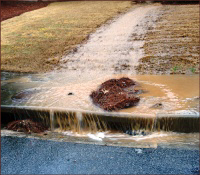For service in the Atlanta, Georgia area contact or call us:
Hydrology Erosion Control
The Cause of Erosion
Hydrology Erosion Control must be carefully monitored during construction.
Erosion is the process of weathering and transport of solids such as sediment, soil, rock and other particles. Erosion occurs over time.
It is the erosion of silt during construction that causes damage to downstream property owners. Construction managers must carefully monitor all erosion control measures after each and every rain. Silt fences must be repaired and replace as needed.
The rate of erosion depends upon many different factors, some of which may include the amount and intensity of the storm even, the frequency of the storm event and geologic factors such as the type of soil and vegetative ground cover.
In recent years, the effects of erosion have significantly increased due to the increase in land development and the increase in stormwater runoff associated with it. Land disturbing activities such as those involved in clearing, dredging, grading, excavating, transporting, and filling can result in soil erosion if not properly controlled by the use of Best Management Practices (BMP's). A lack of BMP's or improper installation of BMP's can result in costly damage to property.
It is Hydrology Erosion Control or the erosion cause by stormwater on a construction site.
Erosion During Construction

During construction, the soil is often exposed to weather for an extended period of time. While the soil is exposed without vegetative ground cover, the soil is more susceptible to being transported by wind or water. When it rains, the water drops collide with the soil and loosen the soil upon impact. As it continues to rain and the soil absorbs the water, the water dissolves the soil and gravity carries the soil / water mixture downstream to the lowest elevation. The rate of the flow of water depends on the slope of the land and the type of surface the water is flowing across. The soil will erode at a faster rate with a greater rate of flow of water.
Post construction, land owners may experience erosion in areas of steep slopes, areas lacking vegetative cover and areas that are constantly exposed to storm water. Residential and commercial properties typically experience problems with erosion at detention ponds, retention ponds, concentrated storm water pipe outlets, streams, creeks, rivers, and other areas that do not have adequate vegetative cover established.
As erosion becomes more of a problem with increasing development, individuals and businesses are facing problems that they have not had to deal with in the past.
Maintaining Detention Ponds
Maintaining detention ponds has been overlooked and forgotten about for years. Ponds are filling up with silt and debris. The become eye sores to the neighborhood.
Often. the responsibility falls to the Homeowners Association (HOA) to remove the silt from these ponds. Unfortunate, these members are unaware of the ponds and how the ponds function and what prevents them from functioning properly.
The purpose of a detention pond is to collect stormwater from a neighborhood and release it at the rate of discharge of the property before it was developed. Zero increase in the rate of runoff.
Over time, detention ponds become filled with silt. Any development upstream will release silt from it site. This silt gradually fills the pond and the design volume decreases and the pond no long functions as it was design.
The stormwater leaves the pond at a faster rate and caused erosion and damage downstream.
Homeowner Associations (HOA) are beginning to be required by local governments to removed the silt from the detention ponds. This is often an expensive process.
Engineers can direct HOAs of the maintenance process and how much silt needs to be removed.
The Hydrology & Erosion Control
During Site Construction
Site engineers design construction projects to prevent stormwater from carrying silt and mud from the construction site. The plans are carefully reviewed by the local permitting agency.
It then becomes the responsibility of the contractor to manage hydrology erosion control measures on the site.
Silt fences must be installed and maintained.
Construction exits must be properly used by vehicles entering and exiting the site. Truck drivers must prevent tracking mud onto streets.
And during construction, temporary basins are very important in preventing sudden release of water, silt and mud on downstream property owners during heavy rains.
Hydrology and Erosion Control are important factors construction workers must be aware of during the disturbance of the site.
Seek out an Engineering Firm that is well equipped to perform site inspections and determine the cause of the erosion. He will determine a cost effective solution that will help prevent erosion in the future. Engineers stay up to date on the latest innovations in preventing erosion and are certified by the Georgia Soil and Water Conservation Commission (GSWCC).
Additional Stormwater Drainage Information:
Find a Drainage Specialist for consultation
Yard Drainage Problems Devalues Property
Simple Solutions to Residential Drainage Problems
Learn the Benefits of Stormwater Drainage Swales
Solving Wet, Soggy Yard Problems
Common Drainage Problems of Homeowners
Preventing Crawl Space Drainage Issues
Do I have a Groundwater Spring on my Property?
Stormwater Damage from the Property Above
Stormwater Utilities and Detention Ponds
Forensic Hydrologist Evaluates Stormwater Runoff
Hydrology Expert Contact Information
Additional Services by Atlanta Engineering Services
G-ZNJ8QW23K9